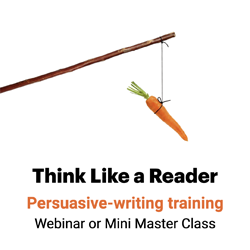No ‘Pat yourself on the back for choosing us’
“Clean your face,” demands a hotel soap wrapper. No, YOU clean YOUR face! I want to respond.

I’ve been seeing a lot of messages like these: messages that sound like benefits but that really are not. Fake benefits.
These fake benefits mirror the structure of benefits messages — Do/this (Save/money) — but not their spirit. Instead, the structure of fake benefits is “Non-benefit-focused verb/feature.”
The structure of benefits messages is:
Do/this
For instance:
Save/money
The structure of fake benefits is:
Non-benefits-focused verb/feature
For instance:
Enjoy/our new product
To move readers to act, avoid these three types of fake benefits.
1. Get our product.
Yesterday, I received an email with this subject line:
“Learn more about New Media Gateway”
While that looks like a benefits statement — it starts with a verb and the implied “you,” after all — it’s actually a fake benefits statement. Its real subject is not the reader, but the communicator’s organization.
Instead of using your verb to point to your product, service, program or idea, write about what readers can do with your product, service, program or idea.
2. ‘Congratulations on choosing us.’
We tend to send these messages out after we win an award: “Pat yourself on the back for choosing us.”
With these benefits, we’re really writing about how great we are:
Get XYZ feature.
Reap many rewards.
Rely on our 75 years of experience.
Value the attention we pay to detail.
Appreciate our dedication to accuracy.
Pat yourself on the back for choosing us.
Instead, write about how the readers’ lives will be different because they chose you.
3. Go to your room.
We learned the imperative voice as the command voice in high school. And it can be a command: Go to your room. Make your bed. Take out the trash.
But you use the imperative voice to move people to act, make it the invitation voice — not the command voice: Save money. Make money. Save time. Avoid effort.
Avoid the command voice. These messages are actually tasks:
Take our class.
Stop by our booth.
Attend our conference.
Subscribe to our newsletter.
Sign up for our webinar.
Make it the invitation voice instead. Rather than tell readers what to do, let them know what they’ll get when they do it:
Learn to double your income when you take our class.
Get a chance at a free Apple Watch when you stop by our booth.
Network with peers — maybe even meet your next boss — when you attend our conference.
Nix ‘get our feature.’
The hardest part of crafting a benefits statement is finding the benefit, not writing the line.
So dig in. Think. Don’t be satisfied with a statement like “Get our feature.” Learn enough about the subject you’re writing about and your audience members to figure out what the former will do for the latter.
Remember what you learned in kindergarten: When you cheat, you only hurt yourself. But when you cheat on benefits statements, you hurt yourself, your readers and your organization.

Leave a Reply